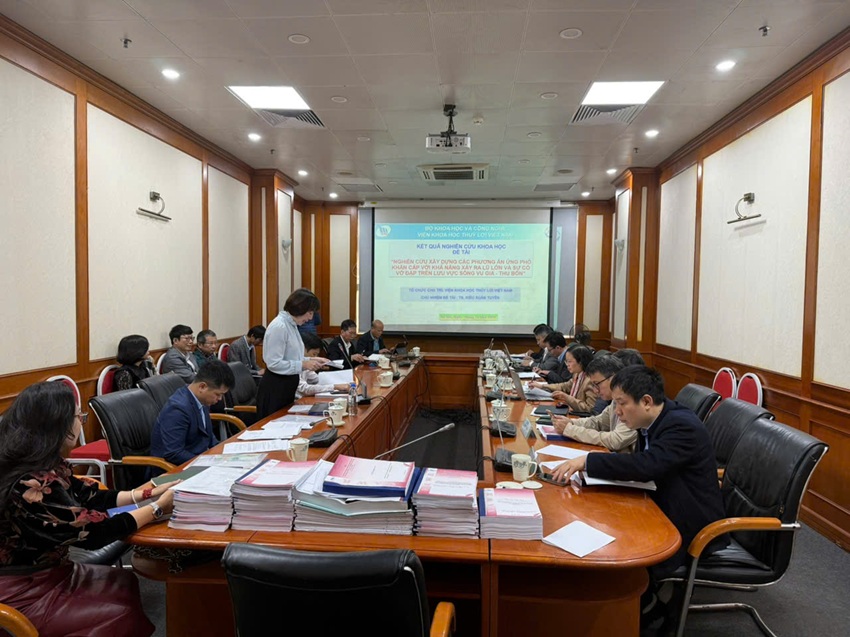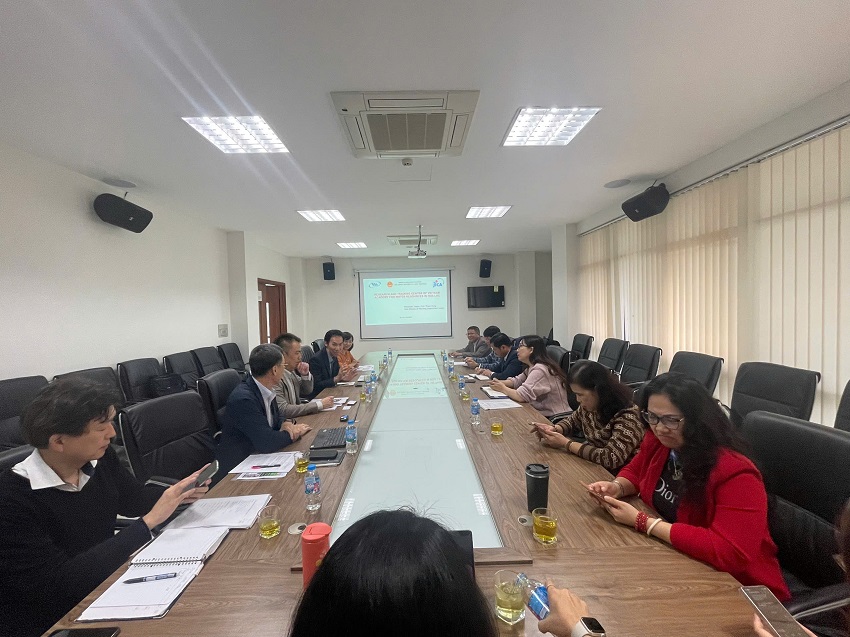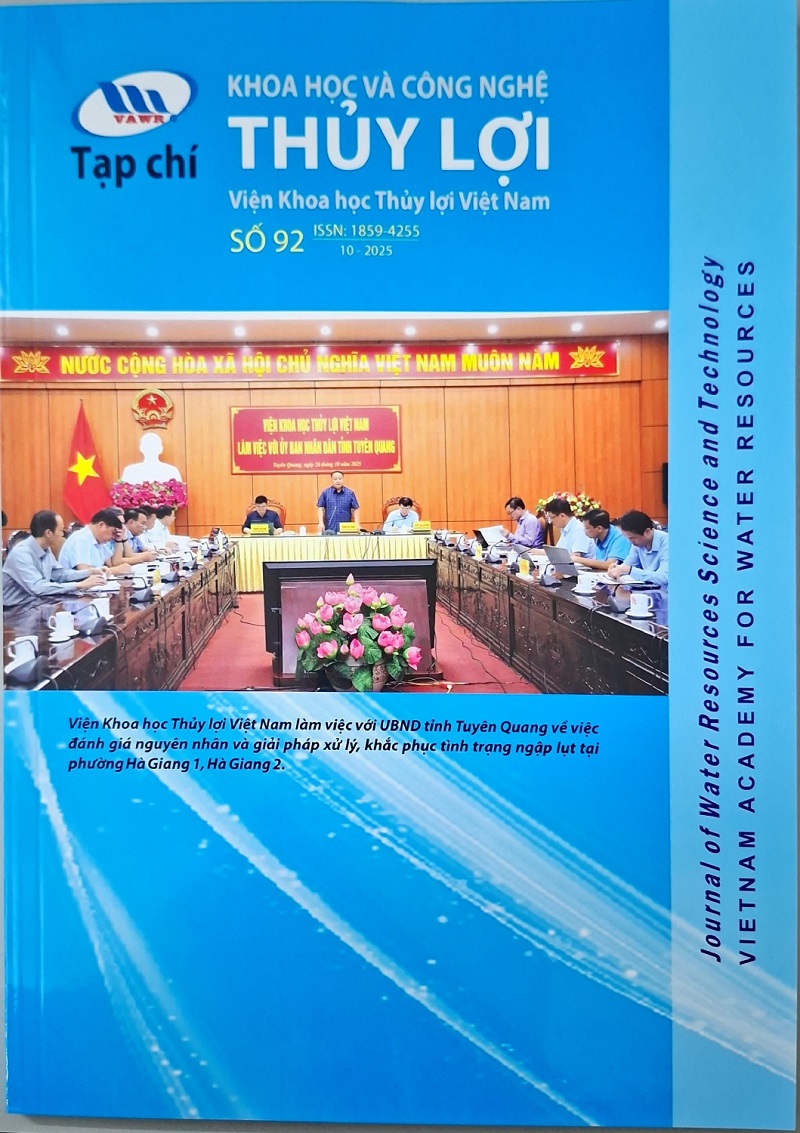Reconstruction and evaluation of changes in hydrologic conditions over a transboundary region by a regional climate model coupled with a physically-based hydrology model: Application to Thao river watershed
17/08/2021The differences among countries in terms of physical features, governmental policies, priorities in shortand long-term water resources management may lead to conflicts in managing and sharing of water resources over the transboundary regions. Due to no formal data sharing agreement between countries, there has been usually no data availability at transboundary regions. In this study, a methodology, in which a physically-based hydrology model was coupled with a regional climate model, is proposed to reconstruct and evaluate hydrologic conditions over transboundary regions. For the case study, Thao river watershed (TRW), within Vietnam and China, was selected. The Watershed Environmental Hydrology (WEHY) model was implemented based on topography, soil, and land use/cover information which was retrieved from global satellite data resources. The watershed model-WEHY was first validated over the TRW, and then was used to reconstruct historical hydrologic conditions during 1950–2007. The results of this study suggest no significant trend in the annual streamflow over the target watershed. In addition, there is a time shift in the wet season between the upstream sector in China and the downstream sector in Vietnam over the TRW. The annual flowcontribution fromthe upstreamsector in China to the outlet of TRW is estimated to be around 66%, and the remaining 34% contribution comes from the downstream sector in Vietnam territory. Last but not the least, the annual flow as a function of return period varies not only with the return period but also as a function of the time window, reflecting the effect of the changing regime on the streamflows at the TRW. The evolution of the flow frequency through time is an evidence of the ongoing non-stationarity in the hydrologic conditions over TRW.
1. Introduction
2. Study region
3. Data andmethodology
3.1. Processing topography, land use/cover, and soil data for TRW
3.2. Processing atmospheric data for TRW
4. Calibration and validation of WEHY model
5. Assessment of hydrologic conditions over the TRW
6. Concluding remarks
Acknowledgements
References
Adger, W.N., Arnell, N.W., Tompkins, E.L., 2005. Successful adaptation to climate change across scales. Glob. Environ. Chang. 15 (2), 77–86 (Jul 1).
Afroz, R., Rahman, M.A., 2013. Transboundary river water for Ganges and Teesta rivers in Bangladesh: an assessment. Glob. Sci. Technol. J. 1 (1), 100–111.
Alcolea, A., Renard, P., 2010. Blocking moving window algorithm: conditioning multiplepoint simulations to hydrogeological data. Water Resour. Res. 46 (8).
Alcolea, A., Carrera, J., Medina, A., 2008. Regularized pilot points method for reproducing the effect of small scale variability: application to simulations of contaminant transport. J. Hydrol. 355 (1–4), 76–90.
Anderson, M.L., Chen, Z.Q., Kavvas, M.L., Yoon, J.Y., 2007. Reconstructed historical atmospheric data by dynamical downscaling. J. Hydrol. Eng. 12 (2), 156–162.
Boé, J., Terray, L., Habets, F., Martin, E., 2007. Statistical and dynamical downscaling of the Seine basin climate for hydrometeorological studies. Int. J. Climatol. 27 (12), 1643–1655.
Brooks, R., Corey, T., 1964. HYDRAU uc Properties of Porous Media. Hydrology papers. 24. Colorado State University, p. 37.
Brower, M.C., Barton, M.S., Lledó, L., Dubois, J., 2013. A Study of Wind Speed Variability Using Global Reanalysis Data (AWS Truepower).
Chen, Z., et al., 2004a. Geomorphologic and soil hydraulic parameters for Watershed Environmental Hydrology (WEHY) model. J. Hydrol.Eng. 6 (465), 465–479. https://doi.org/10.1061/(ASCE)1084-0699(2004)9.
Chen, Z., Kavvas, M., Fukami, K., Yoshitani, J., Matsuura, T., 2004b. Watershed environmental hydrology (WEHY) model: model application. J. Hydrol. Eng. 9:6 (480),480–490. https://doi.org/10.1061/(ASCE)1084-0699(2004)9.
Compo, G.P., Whitaker, J.S., Sardeshmukh, P.D., 2006. Feasibility of a 100-year reanalysis using only surface pressure data. Bull. Am. Meteorol. Soc. 87 (2), 175–190.
Eckstein, G.E., 2009. Water scarcity, conflict, and security in a climate change world: challenges and opportunities for international law and policy. Wis. Int'l LJ. 27, 409.
Fuka, D.R., Walter, M.T., MacAlister, C., Degaetano, A.T., Steenhuis, T.S., Easton, Z.M., 2014. Using the climate forecast system reanalysis as weather input data for watershed models. Hydrol. Process. 28 (22), 5613–5623.
Furat, A.M., Al-Faraj, Scholz, Miklas, 2014. Assessment of temporal hydrologic anomalies coupled with drought impact for a transboundary river flow regime: the Diyala watershed case study. J. Hydrol. 517, 64–73.
Gelhar, L.W., 1986. Stochastic subsurface hydrology from theory to applications. Water Resour. Res. 22 (9S), 135S–145S.
Gleick, P.H., 1993. Water and conflict: fresh water resources and international security. Int. Secur. 18 (1), 79–112.
He, M., Gautam, M., 2016. Variability and trends in precipitation, temperature and drought indices in the state of California. Hydrology 3 (2), 14.
Hengl, T., de Jesus, J.M., MacMillan, R.A., Batjes, N.H., Heuvelink, G.B., Ribeiro, E., Samuel- Rosa, A., Kempen, B., Leenaars, J.G.,Walsh,M.G., Gonzalez, M.R., 2014. SoilGrids1km—global soil information based on automated mapping. PLoS One 9 (8), e105992.
Hersbach, H., Peubey, C., Simmons, A., Poli, P., Dee, D., Berrisford, P., 2013. ERA-20CM: A Twentieth Century Atmospheric Model Ensemble, ERA Report Series 16. European Centre for Medium-Range Weather Forecasts.
Hersbach, H., Peubey, C., Simmons, A., Berrisford, P., Poli, P., Dee, D., 2015. ERA-20CM: a twentieth-century atmospheric model ensemble. Q. J. R. Meteorol. Soc. 141 (691), 2350–2375.
Ho, C., Nguyen, Q., Trinh, T., 2017. Reconstruction of hydrologic data over the Thao river watershed. The Key Laboratory of River and Coastal Engineering (KOLRCEVietnam), Vietnam.
Ho, C., Nguyen, A., Ercan, A., Kavvas, M.L., Nguyen, V., Nguyen, T., 2018. Assessment of atmospheric conditions over the Hong Thai Binh river watershed by means of dynamically-downscaled ERA-20C reanalysis data. J. Water Clim. Chang. https://doi.org/10.2166/wcc.2018.291.
Ishida, K., Gorguner, M., Ercan, A., Trinh, T., Kavvas, M.L., 2017. Trend analysis of watershed-scale precipitation over Northern California by means of dynamicallydownscaled CMIP5 future climate projections. Sci. Total Environ. 592, 12–24.
Jang, S., Kavvas,M.L., 2013. Downscaling global climate simulations to regional scales: statistical downscaling versus dynamical downscaling. J. Hydrol. Eng. 20 (1), A4014006.
Jang, S., Kavvas, M.L., Ishida, K., Trinh, T., Ohara, N., Kure, S., Chen, Z.Q., Anderson, M.L., Matanga, G., Carr, K.J., 2017a. A performance evaluation of dynamical downscaling of precipitation over Northern California. Sustainability 9 (8), 1457.
Jang, S., Kure, S., Ohara, N., Kavvas, M.L., Chen, Z.Q., Carr, K.J., Anderson,M.L., 2017b. Application of WEHY-HCM for modeling interactive atmospheric-hydrologic processes at watershed scale to a sparsely gauged watershed. Sustainability 9 (9), 1554.
Jaw, T., Li, J., Hsu, K.L., Sorooshian, S., Driouech, F., 2015. Evaluation for Moroccan dynamically downscaled precipitation from GCM CHAM5 and its regional hydrologic response. J. Hydrol. 3, 359–378.
Jones, P.G., Thornton, P.K., Heinke, J., 2009. Generating Characteristic Daily Weather Data Using Downscaled Climate Model Data From the IPCC's Fourth Assessment.
Kavvas,M.L., Chen, Z.Q., Dogrul, C., Yoon, J.Y., Ohara, N., Liang, L., Aksoy, H., Anderson, M.L., Yoshitani, J., Fukami, K., Matsuura, T., 2004. Watershed environmental hydrology (WEHY) model based on upscaled conservation equations: hydrologic module. J. Hydrol. Eng. 9 (6), 450–464.
Kavvas,M., et al., 2006. Watershed environmental hydrology model: environmentalmodule and its application to a California watershed. J. Hydrol. Eng. 3 (261), 261–272. https://doi.org/10.1061/(ASCE)1084-0699(2006)11.
Kavvas,M., Kure, S., Chen, Z., Ohara, N., Jang, S., 2012. WEHYHCM for modeling interactive atmospheric-hydrologic processes at watershed scale. I: model description. J. Hydrol. Eng., 1262–1271 https://doi.org/10.1061/(ASCE)HE.1943-5584.0000724.
Kavvas, M.L., Kure, S., Chen, Z.Q., Ohara, N., Jang, S., 2013. WEHY-HCM formodeling interactive atmospheric-hydrologic processes at watershed scale. I: model description. J. Hydrol. Eng. 18 (10), 1262–1271.
Kavvas, M.L., Ishida, K., Trinh, T., Ercan, A., Darama, Y., Carr, K.J., 2017. Current issues in and an emerging method for flood frequency analysis under changing climate. Hydrol. Res. Lett. 11 (1), 1–5.
Krishnamurti, T.N., Jha, B., Rasch, P.J., Ramanathan, V., 1997. A high resolution global reanalysis highlighting the winter monsoon. Part I, reanalysis fields. Meteorog. Atmos. Phys. 64 (3–4), 123–150.
Kure, S., Jang, S., Ohara, N., Kavvas,M., Chen, Z., 2012. WEHYHCM for modeling interactive atmospheric-hydrologic processes at watershed scale. II: model application to ungauged and sparsely gauged watersheds. J. Hydrol. Eng., 1272–1281. https://doi.org/10.1061/(ASCE)HE.1943-5584.0000701.
Kure, S., Jang, S., Ohara, N., Kavvas, M.L., Chen, Z.Q., 2013. WEHY-HCM formodeling interactive atmospheric-hydrologic processes at watershed scale. II: model application to ungauged and sparsely gauged watersheds. J. Hydrol. Eng. 18 (10), 1272–1281.
Lebel, L., Garden, P., Imamura, M., 2005. The politics of scale, position, and place in the governance of water resources in the Mekong region. Ecol. Soc. 10 (2).
Li, Y., He, D., Ye, C., 2008. Spatial and temporal variation of runoff of Red River Basin in Yunnan. J. Geogr. Sci. 18 (3), 308–318.
Lin, L.-F., Ebtehaj, A.M., Bras, R.L., Flores, A.N., Wang, J., 2015. Dynamical precipitation downscaling for hydrologic applications using WRF 4D-var data assimilation: implications for GPM era. J. Hydrometeorol. 16 (2), 811–829.
Linsley Jr., R.K., Kohler, M.A., Paulhus, J., LH, 1982. Hydrology for Engineers. McGraw-Hill Series inWater Resources and Environmental Engineering. McGraw-Hill, Inc, p. 508.
Loveland, T.R., Reed, B.C., Brown, J.F., Ohlen, D.O., Zhu, Z., Yang, L.W.M.J., Merchant, J.W., 2000. Development of a global land cover characteristics database and IGBP DISCover from 1 km AVHRR data. Int. J. Remote Sens. 21 (6–7), 1303–1330.
Milly, P.C., Betancourt, J., Falkenmark, M., Hirsch, R.M., Kundzewicz, Z.W., Lettenmaier, D.P., Stouffer, R.J., 2008. Stationarity is dead: whither water management? Science 319 (5863), 573–574.
Mimides, T., Kotsovinos, N., Rizos, S., Soulis, C., Karakatsoulis, P., Stavropoulos, D., 2007. Integrated runoff and balance analysis concerning Greek-Bulgarian transboundary hydrological basin of River Nestos/Mesta. Desalination 213 (1–3), 174–181.
Ohara, N., Chen, Z.Q., Kavvas, M.L., Fukami, K., Inomata, H., 2010. Reconstruction of historical atmospheric data by a hydroclimate model for the Mekong River basin. J. Hydrol. Eng. 16 (12), 1030–1039.
Pool, M., Carrera, J., Alcolea, A., Bocanegra, E.M., 2015. A comparison of deterministic and stochastic approaches for regional scale inverse modeling on the Mar del Plata aquifer. J. Hydrol. 531, 214–229.
Salas, J. D., Ramirez, J. A., Burlando, P. A. O. L. O., Pielke, R. A., 2003. Stochastic simulation of precipitation and streamflow processes. Handbook of Weather, Climate and Water, 607–640.
Saprisza-Azuri, G.S., Jódar, J., Carrera, J., Gupta, H.V., 2013. Stochastic simulation of nonstationary rainfall fields, accounting for seasonality and atmospheric circulation pattern evolution. Math. Geosci. 45 (5), 621–645.
Sharma, T., Vittal, H., Chhabra, S., Salvi, K., Ghosh, S., Karmakar, S., 2018. Understanding the cascade of GCM and downscaling uncertainties in hydro-climatic projections over India. Int. J. Climatol. 38, e178–e190.
Skamarock, W.C., Klemp, J.B., Dudhia, J., Gill, D.O., Barker, D.M., Wang, W., Powers, J.G., 2005. A description of the advanced research WRF version 2 (no. NCAR/TN-468+ STR). National Center For Atmospheric Research Boulder Co Mesoscale and Microscale Meteorology Div.
Sneddon, C., Fox, C., 2006. Rethinking transboundarywaters: a critical hydropolitics of the Mekong basin. Polit. Geogr. 25 (2), 181–202.
Tachikawa, T., Kaku, M., Iwasaki, A., Gesch, D., Oimoen,M., Zhang, Z., Danielson, J., Krieger, T., Curtis, B., Haase, J., Abrams,M., 2011. ASTER Global Digital ElevationModel Version 2–Summary of Validation Results August 31, 2011.
Trinh, T., Jang, S., Ishida, K., Ohara, N., Chen, Z.Q., Anderson, M.L., Darama, Y., Chen, J., Kavvas, M.L., 2016a. Reconstruction of historical inflows into and water supply from Shasta Dam by coupling physically based hydroclimate model with reservoir operation model. J. Hydrol. Eng. 21 (9), 04016029.
Trinh, T., Ishida, K., Fischer, I., Jang, S., Darama, Y., Nosacka, J., Brown, K., Kavvas, M.L., 2016b. New methodology to develop future flood frequency under changing climate
C. Ho a, T. Trinhb,c,⁎, A. Nguyenc, Q. Nguyena, A. Ercand, M.L. Kavvas c
a The Key Laboratory of River and Coastal Engineering, Viet Nam
b Faculty of Hydrology and Water Resources, Thuy loi University, Viet Nam
c Hydrologic Research Laboratory, Dept. of Civil and Environmental Engineering, Univ. of California, Davis, CA, United States of America
d J. Amorocho Hydraulics Laboratory, Dept. of Civil and Environmental Engineering, Univ. of California, Davis, CA, United States of America
Science of the Total Environment
Ý kiến góp ý:









